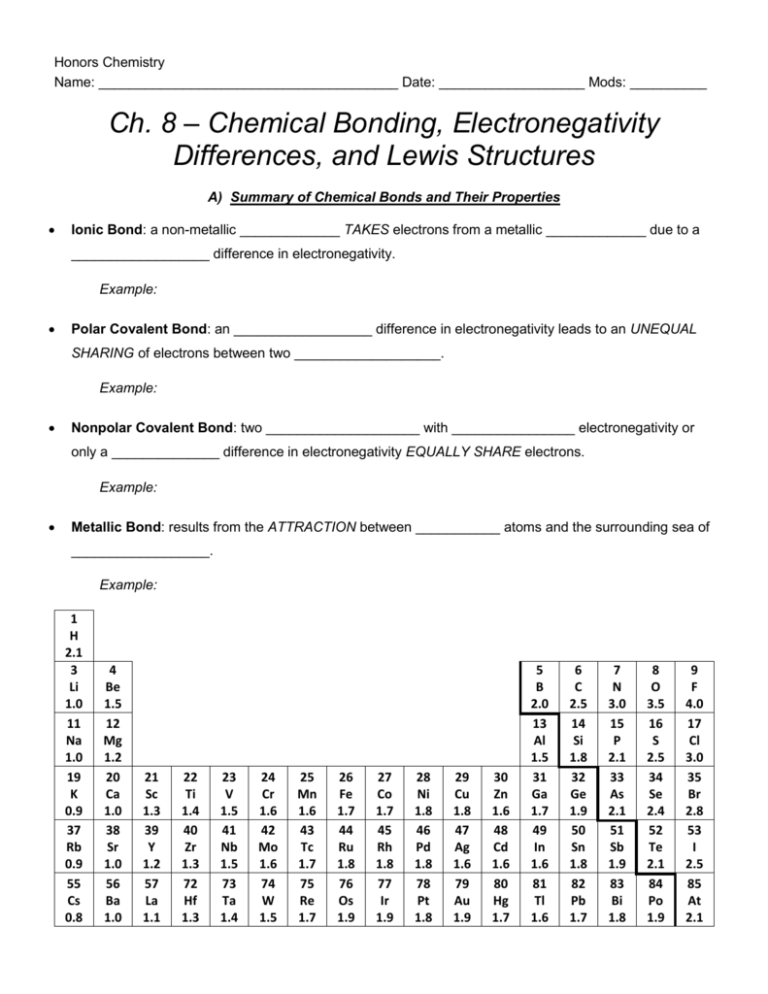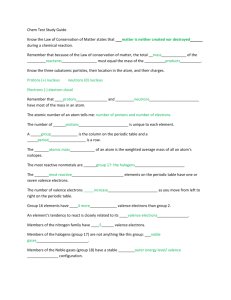Ch. 8 – Chemical Bonding, Electronegativity Differences, and Lewis
advertisement

Honors Chemistry Name: _______________________________________ Date: ___________________ Mods: __________ Ch. 8 – Chemical Bonding, Electronegativity Differences, and Lewis Structures A) Summary of Chemical Bonds and Their Properties Ionic Bond: a non-metallic _____________ TAKES electrons from a metallic _____________ due to a __________________ difference in electronegativity. Example: Polar Covalent Bond: an __________________ difference in electronegativity leads to an UNEQUAL SHARING of electrons between two ___________________. Example: Nonpolar Covalent Bond: two ____________________ with ________________ electronegativity or only a ______________ difference in electronegativity EQUALLY SHARE electrons. Example: Metallic Bond: results from the ATTRACTION between ___________ atoms and the surrounding sea of __________________. Example: 1 H 2.1 3 Li 1.0 11 Na 1.0 19 K 0.9 37 Rb 0.9 55 Cs 0.8 4 Be 1.5 12 Mg 1.2 20 Ca 1.0 38 Sr 1.0 56 Ba 1.0 21 Sc 1.3 39 Y 1.2 57 La 1.1 22 Ti 1.4 40 Zr 1.3 72 Hf 1.3 23 V 1.5 41 Nb 1.5 73 Ta 1.4 24 Cr 1.6 42 Mo 1.6 74 W 1.5 25 Mn 1.6 43 Tc 1.7 75 Re 1.7 26 Fe 1.7 44 Ru 1.8 76 Os 1.9 27 Co 1.7 45 Rh 1.8 77 Ir 1.9 28 Ni 1.8 46 Pd 1.8 78 Pt 1.8 29 Cu 1.8 47 Ag 1.6 79 Au 1.9 30 Zn 1.6 48 Cd 1.6 80 Hg 1.7 5 B 2.0 13 Al 1.5 31 Ga 1.7 49 In 1.6 81 Tl 1.6 6 C 2.5 14 Si 1.8 32 Ge 1.9 50 Sn 1.8 82 Pb 1.7 7 N 3.0 15 P 2.1 33 As 2.1 51 Sb 1.9 83 Bi 1.8 8 O 3.5 16 S 2.5 34 Se 2.4 52 Te 2.1 84 Po 1.9 9 F 4.0 17 Cl 3.0 35 Br 2.8 53 I 2.5 85 At 2.1 87 Fr 0.8 88 Ra 1.0 89 Ac 1.1 B) Using Electronegativity to Predict the Polarity of a Chemical Bond 1 H 2.1 3 Li 1.0 11 Na 1.0 19 K 0.9 37 Rb 0.9 55 Cs 0.8 87 Fr 0.8 1. 4 Be 1.5 12 Mg 1.2 20 Ca 1.0 38 Sr 1.0 56 Ba 1.0 88 Ra 1.0 21 Sc 1.3 39 Y 1.2 57 La 1.1 89 Ac 1.1 22 Ti 1.4 40 Zr 1.3 72 Hf 1.3 23 V 1.5 41 Nb 1.5 73 Ta 1.4 24 Cr 1.6 42 Mo 1.6 74 W 1.5 25 Mn 1.6 43 Tc 1.7 75 Re 1.7 26 Fe 1.7 44 Ru 1.8 76 Os 1.9 27 Co 1.7 45 Rh 1.8 77 Ir 1.9 28 Ni 1.8 46 Pd 1.8 78 Pt 1.8 29 Cu 1.8 47 Ag 1.6 79 Au 1.9 30 Zn 1.6 48 Cd 1.6 80 Hg 1.7 5 B 2.0 13 Al 1.5 31 Ga 1.7 49 In 1.6 81 Tl 1.6 6 C 2.5 14 Si 1.8 32 Ge 1.9 50 Sn 1.8 82 Pb 1.7 7 N 3.0 15 P 2.1 33 As 2.1 51 Sb 1.9 83 Bi 1.8 8 O 3.5 16 S 2.5 34 Se 2.4 52 Te 2.1 84 Po 1.9 9 F 4.0 17 Cl 3.0 35 Br 2.8 53 I 2.5 85 At 2.1 In each pair of bonds, put a star () next to the more polar bond and use an arrow () to show the direction of polarity in each separate bond. 2. a) C—O and C—N c) B—O and B—S b) P—Br and P—Cl d) B—F and B—I For each of the bonds listed below, indicate () which atom is more negatively charged. a) C—N b) C—H c) C—Br d) S—O It is somewhat artificial to classify bonds based on the differences in the electronegativities (X) of the two atoms. However, we will use these ranges to do so: Ionic X > 1.7 (symbolized as A+ and Z-) – full charges Polar Covalent Nonpolar Covalent 3. 1.7 X .5 X < .5 (symbolized as A+ and Z-) – partial charges (no charges) For each of the bonds listed below, classify each bond and indicate full, partial, or no charges. a) Na—Cl e) Mg—H b) C—O f) Cs—F c) Cu—O g) Cl—Cl d) C—H h) Al—Cl C) Rules for Drawing Lewis Structures of Covalently Bonded Molecules (or Polyatomic Ions) 1) Sum the valence electrons from all atoms in the molecule or ion For an ANION add one electron to the total for each negative charge For a CATION subtract one electron from the total for each positive charge 2) Determine the central atom in the molecule and attach all other atoms to it The central atom is the least electronegative element in the compound excluding hydrogen – hydrogen can NEVER be central! (Note: typically, the central atom is the one written first in the molecular formula) Write the symbols for all the other atoms around the central atom. Connect the atoms to the central with a single bond (a dash). Keep track of the electrons being used. Each single bond made uses 2 electrons. Chemical formulas are often written in the order in which the atoms are connected in the molecule (ex: HCN carbon is the central atom) 3) Complete the octets around all the outer atoms bonded to the central using nonbonding electrons ( : ) Note: Hydrogen atoms may only ever have 2 electrons associated with them at any given time Keep track of the electrons being used to complete the octets 4) Place any leftover electrons on the central atom, even if doing so results in more than an octet of electrons around the atom. Note: Expanded octets occur when more than 8 electrons surround an atom. This exception to the octet rule is allowed for any atom in the 3rd row of the periodic table and after! Keep track of the electrons – make sure the total number of valance electrons available were used in the Lewis structure 5) If there are not enough electrons to give the central atom an octet, multiple bonds are needed. Single Bond ( ): Double Bond ( Triple Bond ( ): ): Remove one of the nonbonding pairs of electrons on one of the outer atoms and draw a double bond (2nd dash) connecting the outer atom to the central. If need be, a triple bond (3rd dash) may be formed by removing another nonbonding pair from the same outer atom. Keep track of the electrons – make sure the total number of valance electrons available were used in the Lewis structure Drawing Lewis Structures – In Class Examples Lewis Dot Structures: 1) Methane: CH4 4) Sulfite ion: SO32- 2) Hydrochloric Acid: HCl 5) Hydrocyanic Acid: HCN 3) Ammonia: NH3 6) Methanal (aka: formaldehyde): H2CO Resonance Structures: 7) Nitrite ion: NO2 – Exceptions to the Octet Rule: 1) A central atom which does not have a complete octet (FEWER than 8 electrons) BF3 2) Expanded Octets central atoms which have MORE than 8 electrons (allowed only for atoms in the 3rd period and after) SBr6 Drawing Lewis Diagrams - Practice # of valence e-‘s:________ 1. SF4 3. PO43- 5. N2 # of valence e-‘s:________ # of valence e-‘s:________ 7. CO32- 2. CH2F2 # of valence e-‘s:________ 4. CBr4 # of valence e-‘s:________ 6. CCl2O # of valence e-‘s:________ # of valence e-‘s:________ 8. ClO2- 10. H2S 12. NH4+ # of valence e-‘s:________ # of valence e-‘s:________ # of valence e-‘s:________ 14. NO31- 9. OF2 # of valence e-‘s:________ 11. C2H4 # of valence e-‘s:________ (attach carbons together – make symmetrical) 13. BCl3 # of valence e-‘s:________ # of valence e-‘s:________ 15. IBr5 # of valence e-‘s:________ 17. C2H2 # of valence e-‘s:________ (attach carbons together – make symmetrical) 19. PCl3 # of valence e-‘s:________ 21. PF5 # of valence e-‘s:________ 16. SO42- # of valence e-‘s:________ 18. CO # of valence e-‘s:________ 20. SiO2 # of valence e-‘s:________ 22. PH3 # of valence e-‘s:________ 23. XeF4 # of valence e-‘s:________ 25. CN- # of valence e-‘s:________ 27. C2Br2 # of valence e-‘s:________ (attach carbons together – make symmetrical) 29. SeF4 # of valence e-‘s:________ 24. SeH2 # of valence e-‘s:________ 26. IF3 # of valence e-‘s:________ 28. ClO- # of valence e-‘s:________ 30. AsF3 # of valence e-‘s:________





